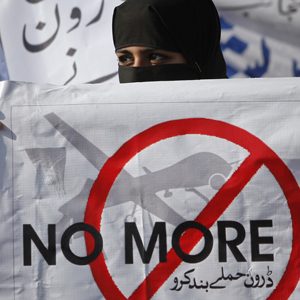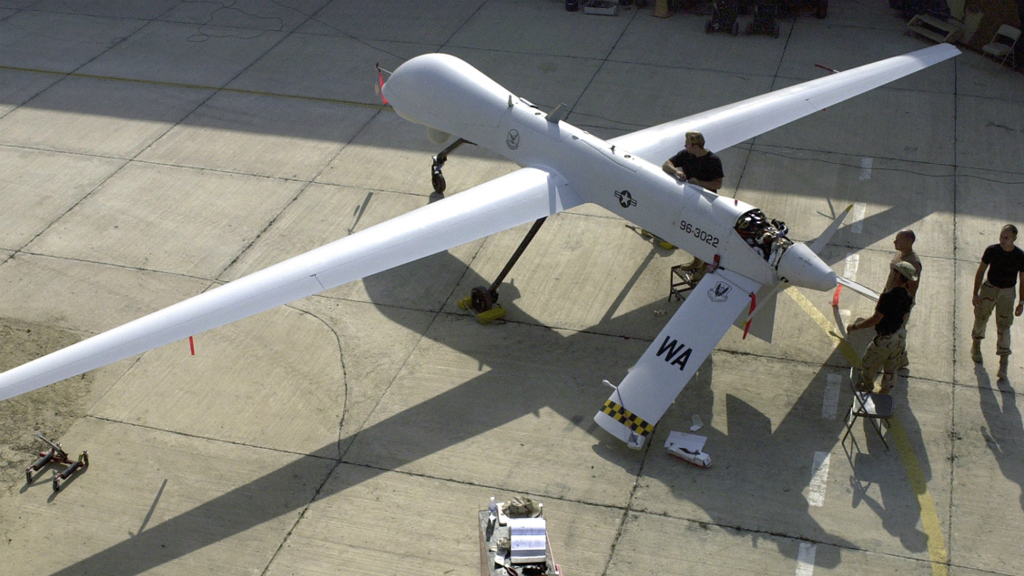‘Terror and stress’ in the shadow of the drones
Civilians in north west Pakistan are suffering “24-hour mental stress” because of the threat of drone strikes, drawing comparisons to the mood after the 9/11 attacks in the US.

A detailed report into the human impact of US drone activity in rural Pakistan found that the aircraft “terrorise” men, women and children “24-hours a day” causing “substantial levels of fear and stress”.
The study states that “these fears are not without a legitimate basis, as drones have reportedly struck schools in the past, resulting in…the deaths of dozens of children.”
The drone campaign is “damaging and counterproductive,” and neither politicians nor the public can “continue to ignore evidence of the civilian harm” it causes, according to academics of Stanford Law School and New York University’s School of Law.
If the strikes are as accurate as being suggested, the identities of the victims should be disclosed for the world to see. Imran Khan
“I know a lot of people, girls and boys, whose families have stopped them from getting an education because of drone attacks,” one Pakistani father told researchers.
The findings echo an investigation by Channel 4 News which found women and children living in a state of panic and fear on a daily basis, with villages and public buildings in Waziristan in the firing line.

Precision killing?
US officials state that drone warfare is their most “precise” weapon in the fight against al-Qaeda terrorists. They insist that civilian deaths are kept to a minimum.
On Monday, Pakistani intelligence officials reported the latest drone attack had killed five militants.
Former Pakistan cricket captain Imran Khan, who will lead a “peace march” march in Waziristan on 7 October, told Channel 4 News: “If the strikes are as accurate as being suggested, the identities of the victims should be disclosed for the world to see the efficacy of the drones in eliminating terrorists.
“We believe that these strikes are killing people indiscriminately.”
Five or 10 minutes after the drone attack, they attack the rescuers who are there. Noor Behram
America’s drone campaign, which is led by the CIA but never publicly acknowledged, has widened extensively under the Obama administration. It has expanded into the Horn of Africa – targeting al-Qaeda affiliates in Somalia and Yemen. But it is rural, mountainous north west Pakistan – close to the Afghan border – which has remained a relentless hunting ground with nearly 300 strikes in three years.
Jonathan Rugman blogs: What is normal about drone warfare?
Mr Khan said: “The people of Waziristan stand isolated, infrastructure has been destroyed, people have been displaced, their children haven’t gone to schools in years and economic activities stand paralysed.
“We believe that continued reliance on military strategy will push the people of the region towards the terrorists. We want to give hope to the people of region and show the world that the way to win this war is to isolate the terrorists and win hearts and minds of the people.”
‘Double-tap’ strikes
The latest report also described the “significant evidence” that exists for the practice of “double-tap” strikes, in which rescuers arriving at the scene are also targeted by follow-up attacks.
Interviewees “explained that the secondary strikes have discouraged average civilians from coming to one another’s rescue, and even inhibited the provision of emergency medical assistance from humanitarian workers.”
I was in New York on 9/11… People were afraid about what might happen next…This is what it is like. It is a continuous tension. Humanitarian worker, Waziristan
“Once there has been a drone strike, people have gone in for rescue missions, and five or 10 minutes after the drone attack, they attack the rescuers who are there,” local journalist Noor Behram said.
‘Continuous tension’
The report said the presence of drones overhead has led to mental health problems in the civilian communities below.
A local taxi driver said: “Whether we are driving a car, or we are working on a farm, or we are sitting at home playing cards – no matter what we are doing we are always thinking the drone will strike us. So we are scared to do anything, no matter what.”
And a humanitarian worker who has worked in areas affected by drones drew parallels with the US after 11 September 2001. “I was in New York on 9/11… People were afraid about what might happen next…This is what it is like. It is a continuous tension.”

Legal fight
Legal challenges involving the use of drones are under way in both Pakistan and Britain, with the US to follow.
Reprieve, which commissioned the Stanford report, is currently bringing a case on behalf of Noor Khan, who lost his father, a local tribal elder, in a strike on a “jirga” – a council used to resolve disputes. Noor is asking the British government to clarify what its policy is on helping the CIA’s drone campaign. This judicial review is due to be heard in court on 23-24 October.
Reprieve’s legal director Clive Stafford-Smith said: “We are also bringing a series of other cases (four to date) in different venues in Pakistan and Europe and, in the end, the US.”
Lawyer Shahzad Akbar, who is representing some of the families of drone victims, told Channel 4 News: “We are making progress, one case in Peshawar high court is making real headway… on how is it determined who is militant and who is not.
“I think compensation is a long way from here but people have started seeing some justice when at least the corridors of power are asked some serious question. This is the beginning of a long-awaited process for justice.”